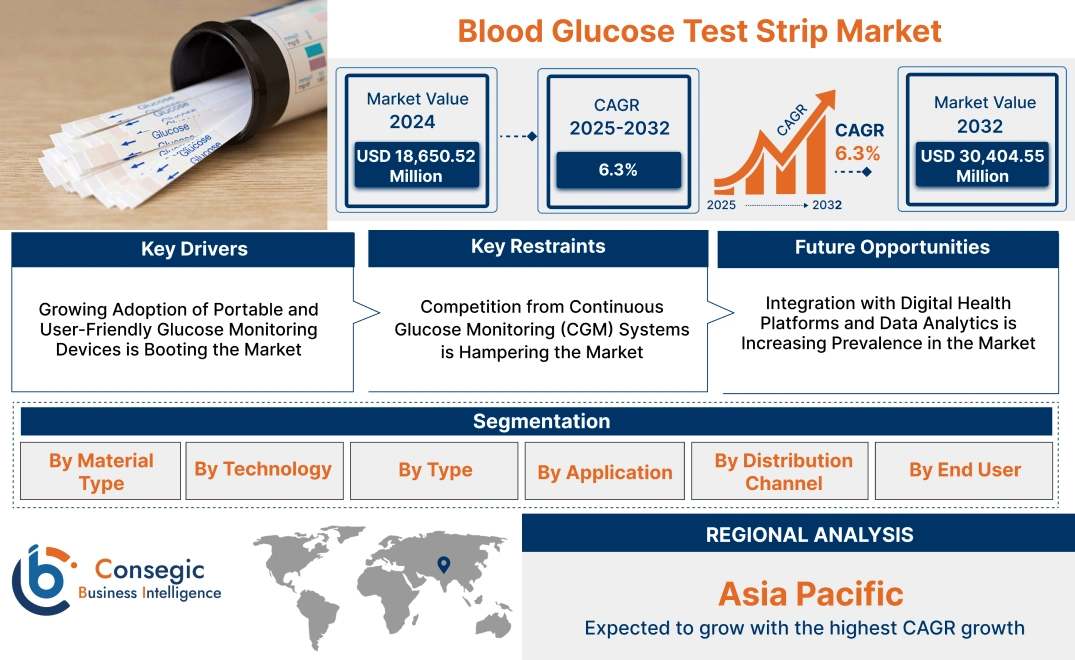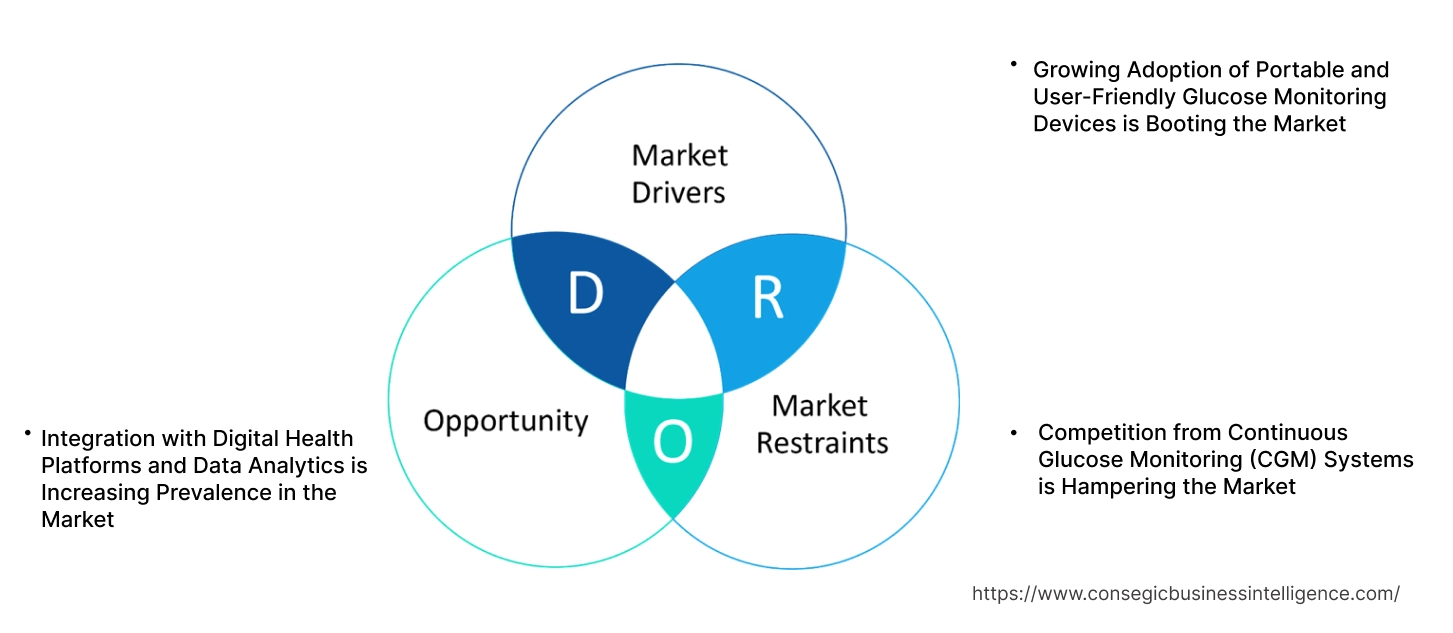- Summary
- Table Of Content
- Methodology
Blood Glucose Test Strip Market Size:
Blood Glucose Test Strip Market size is estimated to reach over USD 30,404.55 Million by 2032 from a value of USD 18,650.52 Million in 2024 and is projected to grow by USD 19,493.18 Million in 2025, growing at a CAGR of 6.3% from 2025 to 2032.
Blood Glucose Test Strip Market Scope & Overview:
The blood glucose test strips are disposable diagnostic tools designed to measure blood glucose levels, primarily used by individuals managing diabetes. These strips, used with blood glucose meters, are critical for self-monitoring and effective diabetes management. Key characteristics of blood glucose test strips include high sensitivity, accuracy in small blood sample analysis, and compatibility with advanced glucose monitoring systems. The benefits include real-time glucose tracking, improved diabetes management, and enhanced convenience for patients. Applications span type 1 and type 2 diabetes monitoring, gestational diabetes management, and routine glucose testing. End-users include individuals, hospitals, clinics, and diagnostic laboratories, driven by the increasing prevalence of diabetes globally, growing awareness of self-monitoring, advancements in glucose testing technology, and supportive healthcare policies encouraging early diagnosis and management.
Key Drivers:
Growing Adoption of Portable and User-Friendly Glucose Monitoring Devices is Booting the Market
The advent of portable and easy-to-use glucose monitoring devices has transformed diabetes management, making it more accessible and convenient for patients. These devices are designed to be compact and user-friendly, enabling individuals to monitor their blood glucose levels effectively at home or while traveling. The integration of advanced technologies, such as one-step testing and quick results, has further enhanced the appeal of these devices among diverse patient populations.
Trends in self-monitoring and proactive healthcare management are supporting the widespread use of these devices in daily diabetes care. The analysis highlights that the convenience and efficiency offered by these portable solutions contribute to better adherence to testing routines, which is critical for managing diabetes and preventing complications.
Key Restraints:
Competition from Continuous Glucose Monitoring (CGM) Systems is Hampering the Market
Continuous Glucose Monitoring (CGM) systems, which provide real-time and continuous tracking of blood glucose levels, are gaining popularity as a less invasive alternative to traditional test strips. These systems eliminate the need for frequent finger pricks and offer a more comprehensive view of glucose demand, appealing to patients who seek advanced monitoring solutions.
While CGM systems represent a significant technological advancement, their higher costs and limited accessibility in certain regions create a competitive challenge for the blood glucose test strip market. Trends in patient preferences for more convenient and holistic monitoring methods underscore the growing competition between these two approaches.
Future Opportunities :
Integration with Digital Health Platforms and Data Analytics is Increasing Prevalence in the Market
The integration of blood glucose test strips with digital health platforms and analytics tools offers a transformative opportunity in diabetes management. These platforms enable patients to record, analyze, and share their glucose data seamlessly, fostering better engagement with healthcare providers. Mobile applications and cloud-based systems enhance the utility of test strips by offering real-time insights and personalized recommendations for managing glucose levels.
Trends in telehealth and personalized medicine emphasize the role of connected healthcare ecosystems in improving patient outcomes. Analysis suggests that manufacturers focusing on compatibility with digital health technologies can create innovative solutions that align with evolving consumer preferences and healthcare delivery models. This integration not only enhances patient experience but also supports data-driven decision-making in diabetes care.
Blood Glucose Test Strip Market Segmental Analysis :
By Material Type:
Based on material type, the is segmented into thick film electrochemical films, thin film electrochemical films, and optical strips.
The thick film electrochemical films segment accounted for the largest revenue share in 2024.
- Thick film electrochemical films are the most commonly used material in blood glucose test strips due to their durability, accuracy, and cost-effectiveness.
- These strips provide reliable results, making them a preferred choice in homecare and clinical settings.
- Increasing trends for self-monitoring devices for diabetes management have driven the adoption of thick film electrochemical test strips.
- Advancements in manufacturing processes have further improved the affordability and scalability of these strips.
The thin film electrochemical films segment is anticipated to register the fastest CAGR during the forecast period.
- Thin film electrochemical films offer high sensitivity and precision, making them ideal for advanced glucose monitoring systems.
- The compact design and reduced material usage of these strips align with the growing trend toward portable and lightweight diabetes devices.
- Rising adoption of technologically advanced diabetes management solutions in developed and emerging markets is driving trends for thin film electrochemical films.
- Increasing focus on environmental sustainability has encouraged the development of eco-friendly thin film materials.
By Technology:
Based on technology, the is segmented into glucose oxidase-based test strips and glucose dehydrogenase-based test strips.
The glucose oxidase-based test strips segment accounted for the largest revenue share in 2024.
- Glucose oxidase-based test strips are widely used for their reliability, accuracy, and affordability in blood glucose monitoring.
- These strips are compatible with a wide range of glucometers, making them accessible for both home and clinical applications.
- The increasing prevalence of diabetes and the growing focus on regular glucose monitoring have driven trends for these strips.
- Advancements in glucose oxidase technology have further improved the accuracy and lifespan of these test strips.
The glucose dehydrogenase-based test strips segment is anticipated to register the fastest CAGR during the forecast period.
- Glucose dehydrogenase-based test strips are gaining popularity for their higher specificity and ability to deliver accurate results, even in the presence of interfering substances.
- These strips are particularly beneficial for patients requiring tighter glycemic control, such as those with gestational diabetes.
- The growing adoption of advanced glucometers with glucose dehydrogenase compatibility is boosting the segment’s rise.
- Rising investments in research and development for next-generation glucose monitoring technologies are expected to further drive adoption.
By Type:
Based on type, the is segmented into disposable test strips and reusable test strips.
The disposable test strips segment accounted for the largest revenue share in 2024.
- Disposable test strips are widely preferred due to their convenience, ease of use, and single-use nature, which ensures hygiene and prevents cross-contamination.
- These strips are a cornerstone of self-monitoring glucose devices, particularly in home care settings.
- The increasing prevalence of diabetes and rising adoption of self-monitoring practices have significantly driven blood glucose test strip market trends for disposable test strips.
- Manufacturers are focusing on improving the accuracy and affordability of disposable test strips to cater to a larger diabetic population.
The reusable test strips segment is anticipated to register the fastest CAGR during the forecast period.
- Reusable test strips offer cost advantages over disposable ones, making them attractive for patients requiring frequent glucose testing.
- The growing emphasis on sustainability and reducing medical waste is driving the adoption of reusable strips.
- Technological advancements in reusable strip design, ensuring high accuracy and durability, are supporting market development.
- Increased availability of innovative glucometers compatible with reusable strips is expected to propel demand further.
By Application:
Based on application, the is segmented into type 1 diabetes, type 2 diabetes, and gestational diabetes.
The type 2 diabetes segment accounted for the largest revenue blood glucose test strip market share of 71.30% in 2024.
- Type 2 diabetes accounts for the majority of diabetes cases worldwide, driving significant trends for glucose test strips.
- The increasing focus on regular glucose monitoring to manage type 2 diabetes effectively has boosted adoption rates.
- Rising awareness about early diagnosis and preventive measures for type 2 diabetes is further propelling segment blood glucose test strip market growth.
- Expanding healthcare access in emerging markets is contributing to the widespread adoption of test strips for type 2 diabetes management.
The gestational diabetes segment is anticipated to register the fastest CAGR during the forecast period.
- Gestational diabetes is becoming increasingly prevalent, particularly among pregnant women in developed and developing countries.
- Frequent glucose monitoring is critical in managing gestational diabetes, and driving blood glucose test strip market demand.
- Growing awareness about the health risks associated with uncontrolled gestational diabetes is boosting the adoption of monitoring devices.
- Increased focus on maternal and fetal health during pregnancy is expected to further support the blood glucose test strip market growth of this segment.
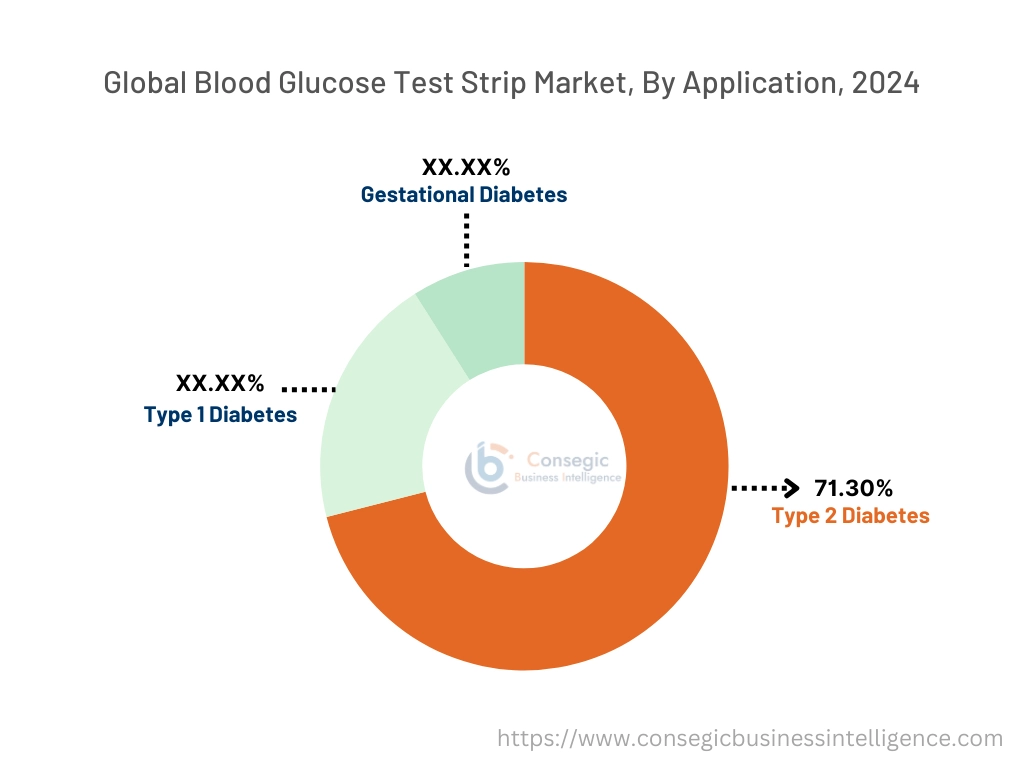
By Distribution Channel:
Based on the distribution channel, the is segmented into hospital pharmacies, retail pharmacies, and online pharmacies.
The retail pharmacies segment accounted for the largest revenue share in 2024.
- Retail pharmacies are a key distribution channel for blood glucose test strips, providing easy accessibility to a wide range of products.
- The growing availability of affordable generic test strips in retail outlets has enhanced market reach.
- Retail pharmacies are well-positioned to serve both urban and rural populations, reinforcing their dominance in the market.
- Collaborative efforts between manufacturers and retail chains to maintain an efficient supply chain have further driven this segment.
The online pharmacies segment is anticipated to register the fastest CAGR during the forecast period.
- Online pharmacies offer the convenience of home delivery, competitive pricing, and accessibility, making them increasingly popular.
- The rising adoption of e-commerce platforms and digital health solutions is driving growth in this segment.
- Increased digital literacy and regulatory support for online pharmacies have boosted their credibility and usage among consumers.
- The COVID-19 pandemic accelerated the adoption of online pharmacy services, a trend that continues to expand post-pandemic.
By End-Use:
Based on end-use, the is segmented into hospitals, homecare settings, diagnostic centers, and others.
The homecare settings segment accounted for the largest revenue blood glucose test strip market share in 2024.
- Homecare settings dominate the market due to the widespread use of self-monitoring devices for diabetes management.
- The convenience and cost-effectiveness of monitoring glucose levels at home have driven the adoption of test strips in this segment.
- Rising awareness about regular glucose monitoring and advancements in home-use glucometers are further supporting growth.
- Increasing focus on patient-centric care and the shift toward home-based management of chronic diseases have reinforced this segment’s dominance.
The diagnostic centers segment is anticipated to register the fastest CAGR during the forecast period.
- Diagnostic centers play a vital role in diagnosing and monitoring diabetes through professional glucose testing services.
- The growing prevalence of diabetes and the emphasis on accurate diagnosis have boosted blood glucose test strip market trends for test strips in diagnostic settings.
- Rising investments in advanced diagnostic technologies and the expansion of diagnostic networks are supporting segment development.
- Increased collaboration between diagnostic centers and manufacturers to offer high-quality glucose monitoring solutions is expected to drive growth further.
Regional Analysis:
The regions covered are North America, Europe, Asia Pacific, the Middle East and Africa, and Latin America.
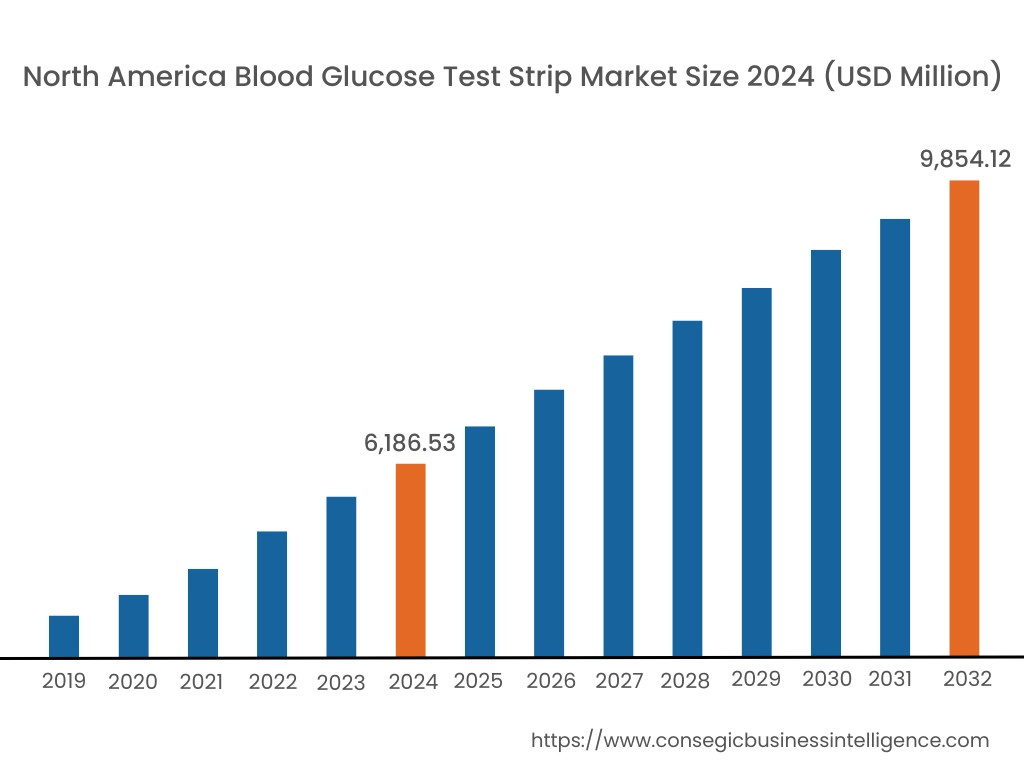
In 2024, North America was valued at USD 6,186.53 Million and is expected to reach USD 9,854.12 Million in 2032. In North America, the U.S. accounted for the highest share of 73.40% during the base year of 2024. North America holds a significant stake in the blood glucose test strip market, driven by the high prevalence of diabetes, advanced healthcare infrastructure, and increasing awareness about self-monitoring of blood glucose (SMBG). The U.S. leads the region with a strong demand for test strips due to a large diabetic population and widespread adoption of advanced blood glucose monitoring devices. As per the blood glucose test strip market analysis, Canada contributes to its growing elderly population and increasing healthcare expenditure on diabetes management. However, the high cost of test strips may limit accessibility for uninsured or low-income populations.
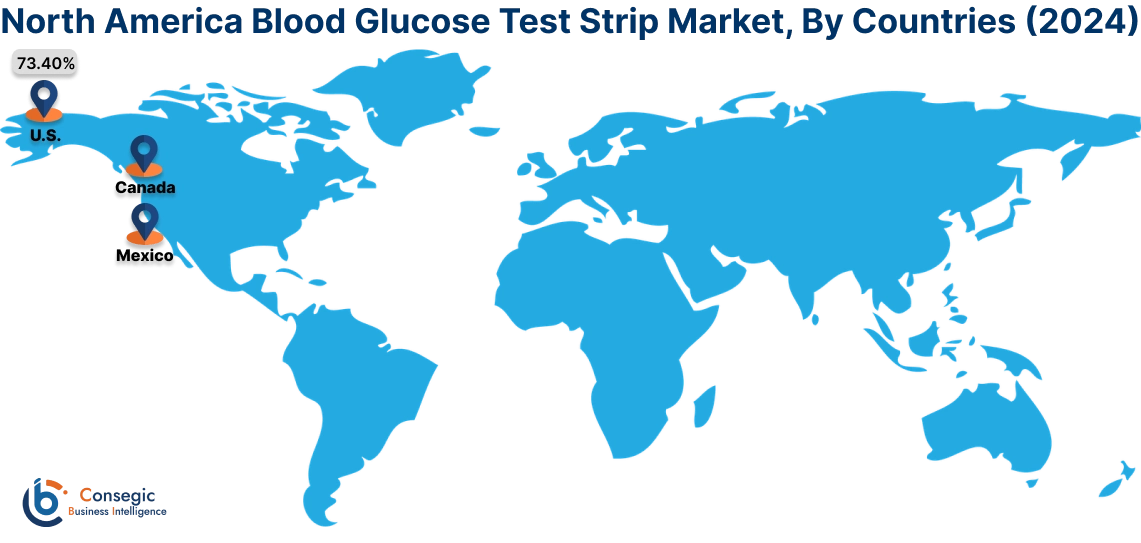
In Asia Pacific, the market is experiencing the fastest growth with a CAGR of 6.7% over the forecast period. The blood glucose test strip analysis is fueled by a rapidly increasing diabetic population, urbanization, and rising healthcare awareness in China, India, and Japan. China dominates the region with a large diabetic population and growing adoption of test strips in urban and rural areas. India’s rising healthcare awareness and government initiatives for diabetes control drive demand for affordable test strips. Japan emphasizes advanced glucose monitoring technologies for its aging population, leveraging high precision and reliability. However, affordability challenges and lack of access to healthcare in rural areas may hinder blood glucose test strip market expansion in emerging economies.
Europe is a prominent market, supported by the analysis of the growing diabetic population, government initiatives for diabetes management, and increasing blood glucose test strip market opportunities for the adoption of home-based monitoring devices. Countries like Germany, France, and the UK are key contributors. Germany drives trends through its robust healthcare system and advanced technologies for SMBG. France emphasizes affordability and access to diabetes management tools through public healthcare programs, while the UK focuses on improving diabetes awareness and promoting self-monitoring to reduce complications. However, budget constraints in public healthcare systems may impact market surge in some regions.
The Middle East & Africa region is witnessing steady growth in the global blood glucose test strip market, driven by the increasing prevalence of diabetes and growing healthcare investments. Countries like Saudi Arabia and the UAE are adopting advanced glucose monitoring systems and test strips to address the high incidence of diabetes in their populations. In Africa, South Africa is an emerging market, focusing on improving access to affordable test strips and diabetes education programs. However, limited healthcare infrastructure and economic constraints in certain parts of the region may restrict broader market development.
Latin America is an emerging market, with Brazil and Mexico leading the region. Brazil’s expanding healthcare sector and growing diabetic population drive blood glucose test strip market demand for test strips in both urban and rural areas. Mexico focuses on increasing access to SMBG tools through government-led diabetes management programs. The region’s emphasis on improving public health infrastructure and raising awareness about diabetes further supports market growth. However, economic instability and inconsistent healthcare policies may pose challenges to market expansion in smaller economies.
Top Key Players and Market Share Insights:
The blood glucose test strip market is highly competitive with major players providing products to the national and international markets. Key players are adopting several strategies in research and development (R&D), product innovation, and end-user launches to hold a strong position in the blood glucose test strip market. Key players in the blood glucose test strip industry include -
- Abbott Laboratories (United States)
- Roche Diagnostics (Switzerland)
- AgaMatrix, Inc. (United States)
- Medtronic plc (Ireland)
- Prodigy Diabetes Care, LLC (United States)
- LifeScan, Inc. (United States)
- Ascensia Diabetes Care (Switzerland)
- Dexcom, Inc. (United States)
- Braun Melsungen AG (Germany)
- Trividia Health, Inc. (United States)
Blood Glucose Test Strip Market Report Insights :
| Report Attributes | Report Details |
| Study Timeline | 2019-2032 |
| Market Size in 2032 | USD 30,404.55 Million |
| CAGR (2025-2032) | 6.3% |
| By Material Type |
|
| By Technology |
|
| By Type |
|
| By Application |
|
| By Distribution Channel |
|
| By End-Use |
|
| By Region |
|
| Key Players |
|
| North America | U.S. Canada Mexico |
| Europe | U.K. Germany France Spain Italy Russia Benelux Rest of Europe |
| APAC | China South Korea Japan India Australia ASEAN Rest of Asia-Pacific |
| Middle East and Africa | GCC Turkey South Africa Rest of MEA |
| LATAM | Brazil Argentina Chile Rest of LATAM |
| Report Coverage |
|
Key Questions Answered in the Report
What is the projected market size of the Blood Glucose Test Strip Market by 2032? +
Blood Glucose Test Strip Market size is estimated to reach over USD 30,404.55 Million by 2032 from a value of USD 18,650.52 Million in 2024 and is projected to grow by USD 19,493.18 Million in 2025, growing at a CAGR of 6.3% from 2025 to 2032.
What factors are driving the growth of the blood glucose test strip market? +
Key drivers include the growing prevalence of diabetes, increased adoption of self-monitoring glucose devices, advancements in glucose monitoring technology, and rising awareness about the importance of regular glucose testing for effective diabetes management.
What challenges are faced by the blood glucose test strip market? +
The market faces competition from Continuous Glucose Monitoring (CGM) systems, which offer real-time, less invasive glucose tracking. Additionally, the high cost of test strips in some regions may limit their accessibility.
Which material type dominates the market? +
Thick film electrochemical films hold the largest market share due to their durability, cost-effectiveness, and reliable performance in blood glucose monitoring.
Which material type is expected to grow the fastest? +
Thin film electrochemical films are anticipated to grow at the fastest CAGR, driven by their precision, compact design, and compatibility with advanced glucose monitoring devices.
